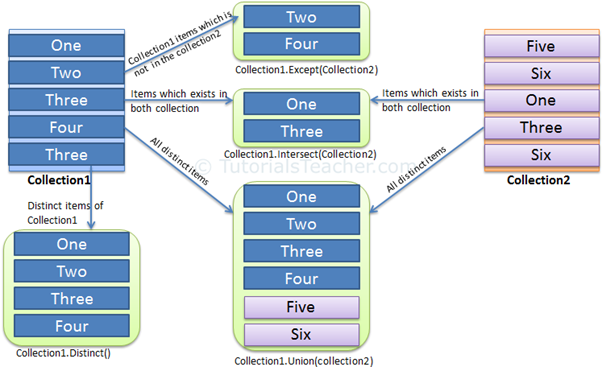| Set Operators | Usage |
|---|---|
| Distinct | 去掉集合的重复项 |
| Except | 返回两个集合的不同,第一个集合的元素不能出现在第二个集合中 |
| Intersect | 返回两个集合的交集,即元素同时出现在两个集合中 |
| Union | Returns unique elements from two sequences, which means unique elements that appear in either of the two sequences. |

IList<string> strList = new List<string>(){ "One", "Two", "Three", "Two", "Three" }; IList<int> intList = new List<int>(){ 1, 2, 3, 2, 4, 4, 3, 5 }; var distinctList1 = strList.Distinct(); foreach(var str in distinctList1) Console.WriteLine(str); var distinctList2 = intList.Distinct(); foreach(var i in distinctList2) Console.WriteLine(i);
如果要去掉复杂类型的重复项,需要实现IEqualityComparer接口
public class Student { public int StudentID { get; set; } public string StudentName { get; set; } public int Age { get; set; } } class StudentComparer : IEqualityComparer<Student> { public bool Equals(Student x, Student y) { if (x.StudentID == y.StudentID && x.StudentName.ToLower() == y.StudentName.ToLower()) return true; return false; } public int GetHashCode(Student obj) { return obj.StudentID.GetHashCode(); } }
IList<Student> studentList = new List<Student>() { new Student() { StudentID = 1, StudentName = "John", Age = 18 } , new Student() { StudentID = 2, StudentName = "Steve", Age = 15 } , new Student() { StudentID = 3, StudentName = "Bill", Age = 25 } , new Student() { StudentID = 3, StudentName = "Bill", Age = 25 } , new Student() { StudentID = 3, StudentName = "Bill", Age = 25 } , new Student() { StudentID = 3, StudentName = "Bill", Age = 25 } , new Student() { StudentID = 5, StudentName = "Ron" , Age = 19 } }; var distinctStudents = studentList.Distinct(new StudentComparer()); foreach(Student std in distinctStudents)
Except
第一个集合的元素不在第二个集合中出现,返回新的集合
IList<string> strList1 = new List<string>(){"One", "Two", "Three", "Four", "Five" }; IList<string> strList2 = new List<string>(){"Four", "Five", "Six", "Seven", "Eight"}; var result = strList1.Except(strList2); foreach(string str in result) Console.WriteLine(str);
public class Student { public int StudentID { get; set; } public string StudentName { get; set; } public int Age { get; set; } } class StudentComparer : IEqualityComparer<Student> { public bool Equals(Student x, Student y) { if (x.StudentID == y.StudentID && x.StudentName.ToLower() == y.StudentName.ToLower()) return true; return false; } public int GetHashCode(Student obj) { return obj.StudentID.GetHashCode(); } }
public class Student { public int StudentID { get; set; } public string StudentName { get; set; } public int Age { get; set; } } class StudentComparer : IEqualityComparer<Student> { public bool Equals(Student x, Student y) { if (x.StudentID == y.StudentID && x.StudentName.ToLower() == y.StudentName.ToLower()) return true; return false; } public int GetHashCode(Student obj) { return obj.StudentID.GetHashCode(); } }
Intersect
返回两个集合的交集
IList<string> strList1 = new List<string>() { "One", "Two", "Three", "Four", "Five" }; IList<string> strList2 = new List<string>() { "Four", "Five", "Six", "Seven", "Eight"}; var result = strList1.Intersect(strList2); foreach(string str in result) Console.WriteLine(str);
复杂类型的交集需要实现IEqualityComparer<T>接口
public class Student { public int StudentID { get; set; } public string StudentName { get; set; } public int Age { get; set; } } class StudentComparer : IEqualityComparer<Student> { public bool Equals(Student x, Student y) { if (x.StudentID == y.StudentID && x.StudentName.ToLower() == y.StudentName.ToLower()) return true; return false; } public int GetHashCode(Student obj) { return obj.StudentID.GetHashCode(); } }
IList<Student> studentList1 = new List<Student>() { new Student() { StudentID = 1, StudentName = "John", Age = 18 } , new Student() { StudentID = 2, StudentName = "Steve", Age = 15 } , new Student() { StudentID = 3, StudentName = "Bill", Age = 25 } , new Student() { StudentID = 5, StudentName = "Ron" , Age = 19 } }; IList<Student> studentList2 = new List<Student>() { new Student() { StudentID = 3, StudentName = "Bill", Age = 25 } , new Student() { StudentID = 5, StudentName = "Ron" , Age = 19 } }; var resultedCol = studentList1.Intersect(studentList2, new StudentComparer()); foreach(Student std in resultedCol) Console.WriteLine(std.StudentName);
Union
两个集合的并集
IList<string> strList1 = new List<string>() { "One", "Two", "three", "Four" }; IList<string> strList2 = new List<string>() { "Two", "THREE", "Four", "Five" }; var result = strList1.Union(strList2); foreach(string str in result) Console.WriteLine(str);
复杂类型的并集需要实现IEqualityComparer<T>接口
public class Student { public int StudentID { get; set; } public string StudentName { get; set; } public int Age { get; set; } } class StudentComparer : IEqualityComparer<Student> { public bool Equals(Student x, Student y) { if (x.StudentID == y.StudentID && x.StudentName.ToLower() == y.StudentName.ToLower()) return true; return false; } public int GetHashCode(Student obj) { return obj.StudentID.GetHashCode(); } }
IList<Student> studentList1 = new List<Student>() { new Student() { StudentID = 1, StudentName = "John", Age = 18 } , new Student() { StudentID = 2, StudentName = "Steve", Age = 15 } , new Student() { StudentID = 3, StudentName = "Bill", Age = 25 } , new Student() { StudentID = 5, StudentName = "Ron" , Age = 19 } }; IList<Student> studentList2 = new List<Student>() { new Student() { StudentID = 3, StudentName = "Bill", Age = 25 } , new Student() { StudentID = 5, StudentName = "Ron" , Age = 19 } }; var resultedCol = studentList1.Union(studentList2, new StudentComparer()); foreach(Student std in resultedCol) Console.WriteLine(std.StudentName);